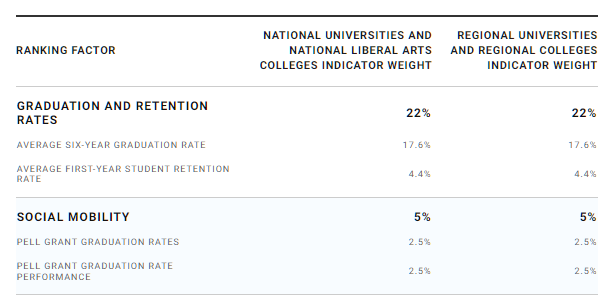Blog Post #1
College Ranking Criteria and Their Weights
As college is a very important period of someone’s life, it is understandable that they may aim to go to higher-ranked institutions. Surely many students in college or applying to colleges will remember looking at the top-ranked colleges in the nation or for their major. These sites were always helpful in finding potential schools that would fit the student’s needs. That being said, it is also important to recognize how these colleges are ranked. Below is an image of the ranking criteria and their respective weights according to usnews.com:

This table can be accessed via A More Detailed Look at the Ranking Factors.
Why This Dataset and its Origins?
I chose this data set because it relates to me. I can still remember the college application process where I would look up the top-ranked colleges to choose. Also, I was interested in learning more about the criteria that is used to rank colleges. I think the ranking is very important because it can largely influence a student’s decision to apply or even attend a university. Therefore, the criteria should be the least biased and most representative.
The US News & World Report published their ranking of the top universities in the nation. They explain that they use 17 factors of quality which are used to determine the rankings. These factors don’t have equal weight. As a result, US News included this dataset in order to help visualize how much each of the 17 criteria points as a percentage affects a college’s ranking. The college rankings might be very beneficial to many high school students looking to apply to colleges. Therefore, releasing a rundown to help understand how the rankings are achieved will better reinforce those rankings.
Gaps and Limitations of the Data Set
While the site conveniently explains their reasoning behind each criteria point, there still remain limitations from the data they analyze. Some sections of the criteria are very vague, leaving room for potential biases. For example, one particular section is the Undergraduate Academic Reputation.

The site explains that presidents, provosts, and deans of peer institutions are surveyed about the different undergraduate academic programs of a certain school. These survey responses are rated on a scale of 1 through 5 describing the programs from marginal to distinguished respectively. These responses are then averaged out to qualify the ranking of the school. However, using surveys for “expert opinions” as referred by the US News, could turn out to be counterproductive to the rankings. If a peering administrator favors a specific school, their survey responses may favor that specific institution. Including surveys therefore could conclude with more biases. This “expert opinion” also accounts for 20 percent of the ranking which is a fairly large portion.
Potential questions
One question that came to mind is if there is a better way to use expert opinion to evaluate school program effectiveness. Perhaps instead of conducting surveys, data could be collected in regards to the popularity of such programs in the universities and the rates of students graduating with a job. While this may provide better insight into college programs and help us understand how the college programs are, it could potentially make the data collection more complicated. This brings me to the next question which is how can we find the proper balance between ranking criteria complexity with efficiency while keeping biases minimal? Overall this dataset provided by the US News is great at explaining the criteria that are accounted for when ranking colleges. However, it is evident that there is more room for improvement which involves reducing potential biases.
Guest post by: Jonathan V.